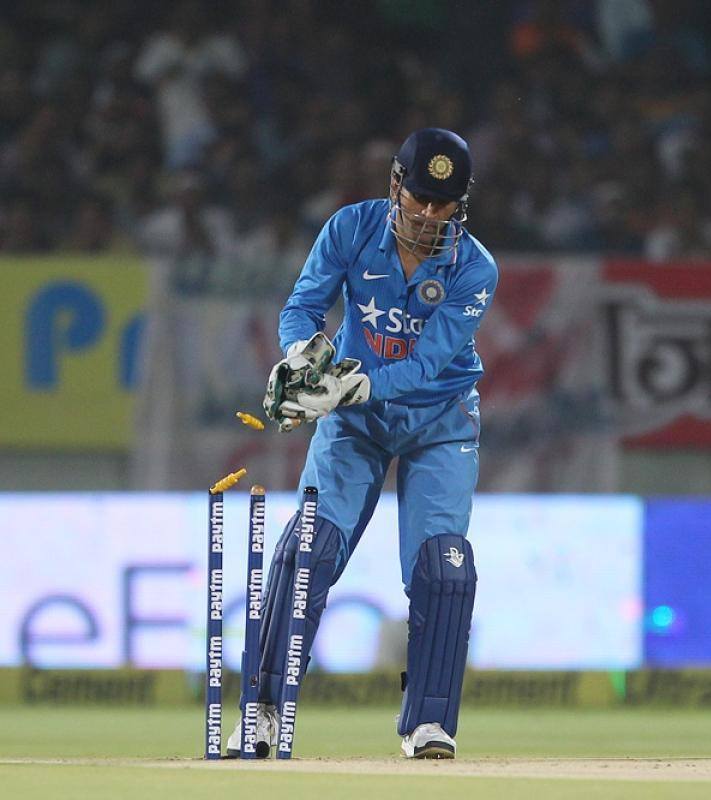
The murmurs are no longer an irritable hum that can be drowned out by ramping up the volume. What started as veiled insinuation has steadily taken the voice of ruthless appraisal, the kinds that ironically, Mahendra Singh Dhoni in his pomp piloted. Remember the nudge to ‘slow legs’ during India’s misbegotten tour to Australia in 2011-12?
Sport, as in life, has a happy predilection of throwing funny things at its practitioners, except it’s not too funny for those at the receiving end. VVS Laxman said it. Ajit Agarkar nailed it. Virender Sehwag spelled it. Sourav Ganguly sealed it. All these players know a thing or two about international cricket. Dhoni’s waning powers are an open secret and no stout defence not even the passionate kinds that skipper Virat Kohli put up after India sealed the T20 series against New Zealand-can eclipse the fact that it might be getting to a point where opposition bowlers fancy a chance bowling to Dhoni, as opposed to the nervous wreck he would reduce them to by his mere presence some years back.
 The problem is, bowlers around the world have found a way to keep him quiet, and surprisingly for an inventive, street-smart cricketer that he is, Dhoni is yet to find a way to decode the puzzle. It happened briefly in the earlier part of his career too, when he would be tied down by fastish , accurate, off-spin. One remembers Marlon Samuels, in particular, darting in his innocuous lobs at his feet, cramping him for room to swing his powerful arms.
The problem is, bowlers around the world have found a way to keep him quiet, and surprisingly for an inventive, street-smart cricketer that he is, Dhoni is yet to find a way to decode the puzzle. It happened briefly in the earlier part of his career too, when he would be tied down by fastish , accurate, off-spin. One remembers Marlon Samuels, in particular, darting in his innocuous lobs at his feet, cramping him for room to swing his powerful arms.
What separates Dhoni of noughties to this Dhoni is his ability to adapt. To counter his problems against off-spin, he began stepping out. He would rarely sweep, but had the power to launch a six from the crease or bring out his trademark ‘helicopter shot.’ He ensured those extra dot-balls that he faced didn’t hurt the team; he would target other bowlers, milk the spin and run really hard. While running is never an issue with Dhoni, what has been his bane is the inability to find singles at will. With an army of analysts at their disposal, captains and bowlers across the world have realised the importance of cramping him early. They employ a left-arm spinner early into his innings. The brief is simple: bowl wide yorkers outside the off-stump, or use the natural angle to
bring the bowl into him.
The more skilled ones, like New Zealand’s Mitchell Santner, hardly err in line or length, leaving Dhoni very little to work with. The ploy appears foolproof, except that it’s not. Someone like Virat Kohli has repeatedly displayed the trick to work with angles and pace. The ingenuity of the Indian skipper ensures he makes his own length with wide yorkers; he reaches close to such deliveries and plays them over covers, forcing the bowler to bowl closer to his body. Once the bowler obliges, it opens the entire region from extra-cover to deep mid-wicket for Kohli, who can either pepper the off-side with inside-out shots, or use sweeps and slog sweeps to go over the cow-corner.
By contrast, Dhoni seems to have just too few big shots against spinners. Bowl him on length and on fourth stump, and Dhoni will step out to deposit you over the sight-screen or mid-wicket,but bowl him within stumps, and he struggles. He rarely sweeps, doesn’t go inside-out and (thankfully) doesn’t try revere-sweeps. Occasionally, he does use the paddlesweep, but it’s more a deflection for a single or double than the proper thwack that Sachin Tendulkar patented.
Dhoni’s other problem is against military-medium pacers bowling back of length to him. Here again, he has shown the propensity to misread the slower balls and spoon a catch to short-cover or midoff. Someone like a Rohit Sharma or a Virat Kohli would move towards the leg-stump to create width and fl at-bat a shot over point or covers. The bowler invariably compensates by bowling fuller, and that’s when sizzling drives through the off-side can come out. Dhoni prefers to play with his hands alone, and when cramped for room and given very little pace to work with, he ends up consuming a lot of dot balls.

During the second T20 against New Zealand in Rajkot, he arrived in the 10th over of India’s innings- clearly a luxury for most batsmen. The required rate was already about 12 runs-an-over, and at one point, he was batting at 27 off 27 balls, going at exactly half the required rate. He had a 44-ball partnership with Virat Kohli, faced 24 of those balls and scored only 25.
India lost the match there. While his relevance in One-Day Internationals (ODIs) is still unparalleled, he might be coming to an end of his T20 sojourn. The option for India’s team management could be to play Rishabh Pant or KL Rahul, both of who score quickly and can keep wickets, or send Dhoni at number four. Both views have their merit; the first could be a stepping stone for a youngster in post-Dhoni era, while the second would allow Dhoni the license to play himself in before launching, leaving on-demand power-hitting to Hardik Pandya or Manish Pandey.
India host Sri Lanka next, and the teams will play three T20Is to cap the tour. Will the series see a change in approach from Dhoni or will Kohli tinker with the batting order, only time will tell. For now, the murmurs are growing.








